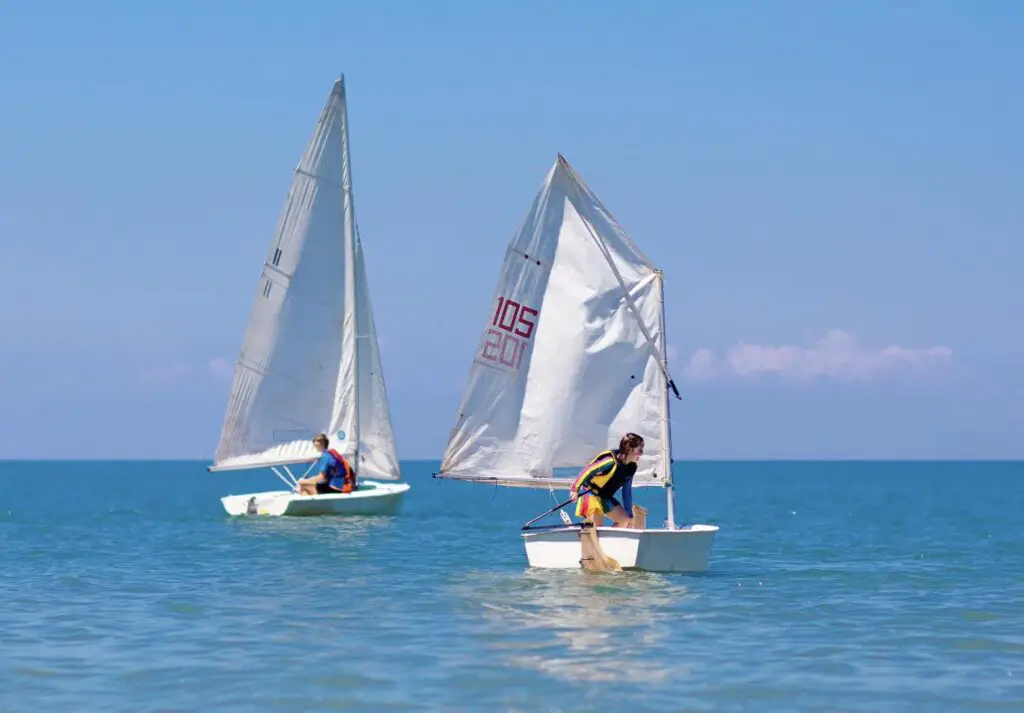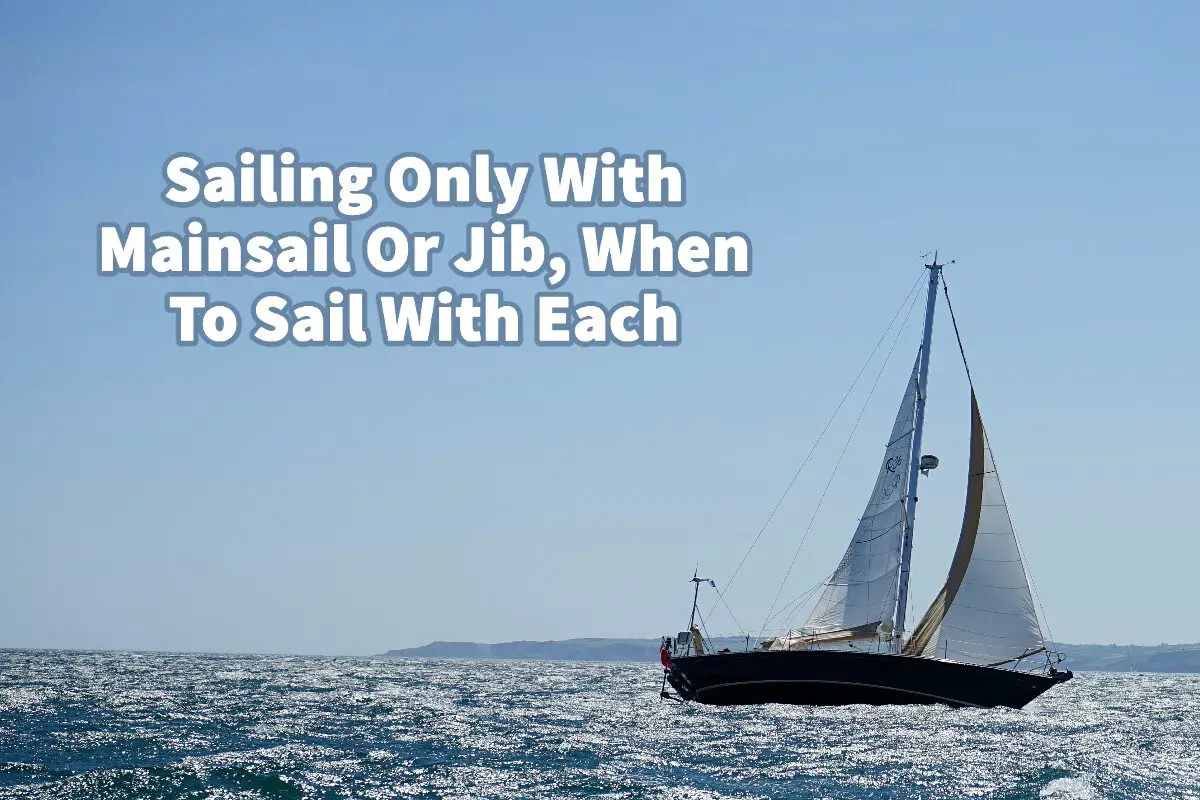Sailing with just the mainsail or jib can be intimidating if you’re a beginner sailor. Knowing which sail to use at what time is essential for successful and safe sailing. With the right techniques, you’ll be able to choose between mainsail-only sailing in no time! I
As the name implies, the mainsail is the sail that most people think of as the boat’s most significant and crucial sail; it is the sail near the stern or back of the sailboat. The jib is the sail at the front of the boat. You can easily sail with just the mainsail, and there may be reasons why it may be better for you to do so. Sailing with only the jib sail is more tricky as the jib sail alone will only work with a downwind.
Table of Contents
- Mainsail and Jib Explained
- Can You Sail With Just The Mainsail Alone?
- Can You Sail With Just the Jib Sail?
- 12 Reasons Why Taking A Sailing Class Is Essential for Aspiring Sailors
- Related Questions
Mainsail and Jib Explained
If you are starting to learn to sail, it can be unclear when it is best to sail with just the mainsail or jib and when to sail with both. We need to know the difference between the mainsail and jib sail to understand this.
What Is The Mainsail?
The mainsail is the sail located the furthest back on the sailboat or the sail that is back towards the stern of the boat. It is attached to the boom. The boom is the horizontal rod that is attached to the mast.
The mainsail is usually the largest sail that most people think about when sailing a sailboat. The mainsail will swing on the boom to tack or jive with the boat when the sailboat turns.
The mainsail is usually raised first as it is an essential sail on a sailboat. The mainsail is your powerhouse, and your boat will get most of its momentum from the mainsail.
What Is the Jib Sail?
The jib sail is a triangular sail that sits at the head of the foremast of a sailing vessel. It is a sail tacked to the boat’s bow and is considered a headsail or a sail at the front of the boat.
Unlike the mainsail, the job has no sail cover and no sail ties so that it can catch all kinds of wind on the downwind leg of your sailing. Because of this, it is hard to sail with just the jib sail with a downwind.
There are two main types of headsails or sails at the front of the boat: spinnakers and jib sails. Though they are both at the front of the boat, they are not the same sail.

Can You Sail With Just The Mainsail Alone?
Any sailboat can be sailed with just the mainsail. When you decide to cut the jib sail and sail with the mainsail alone, a few things will happen.
- Speed Will Be Reduced – If you are sailing and the winds are excessively high, and you want to reduce the speed so your boat is easier to handle, you can cut the jib sail and sail with only the mainsail.
- Can Increase Visibility – There may be times when you can not see at the front of the boat, so you may need to cut the jib sail to have better visibility.
- Want To Sail Casually – If you are going on a casual sail and want to coast along, you can cut the jib sail and use the mainsail to sail to reduce your speed.
- Sailing Solo – If you sail solo and want to handle the boat better, you can sail with just the mainsail. Sailing with the mainsail will make the boat easier for you. It is usually easier to steer the boat if you do not need to worry about trying to raise the jib sail.
- Monohull Sailboat – If you are sailing a monohull sailboat, where the boat is made to rise with the wind, the boat is easier to handle with just the mainsail. If you are not experienced in sailing this kind of boat, too much wind can cause the sailboat to keel over, so you may want to have just the mainsail up to limit the tilting of the boat.
- Choppy Waves – If the waves are incredibly choppy, you may find it easier to sail with just the mainsail.
- Impeding Storm – If you are out on the water and suddenly see that a storm is arising, you may want to cut the Jib sail to slow down and sail safely to shore or the dock with just the mainsail.
Can You Sail With Just the Jib Sail?
The jib sail is not the same as the mainsail, so it cannot do the same things that the mainsail can. You can sail alone with the jib sail but only downwind and not upwind. If you try to sail with the jib sail alone in the upwind, it will cause you to go around in circles.
Here are a few things to remember about sailing alone with the jib and not the mainsail:
- The Wind – being able to sail with only the jib will depend significantly on the wind direction and where and how the wind is going. It is not the same as the mainsail that can be used alone with all kinds of wind directions.
- Downwind Is Needed – To sail alone with only the jib, you need a downwind. The direction or the lack of wind direction can limit how you can sail with just the jib sail.
- Useless In Upwind – The jib sail alone is futile in the upwind. You must also have the mainsail up for the jib sail to work in the upwind.
If you want to sail with just one sail, you should sail with just the mainsail and not just the jib sail. Especially if you are a beginning sailor, just sailing with the mainsail will be easier for you to handle than trying to sail alone with the jib.
12 Reasons Why Taking A Sailing Class Is Essential for Aspiring Sailors
Sailing is an exhilarating experience that offers a unique blend of freedom, challenge, and connection with nature. But like any other skill, mastering it requires proper guidance and training.

From my perspective, if you’re keen on learning how to sail, enrolling in a class is imperative.
Here are 12 Reasons Why Taking a Saling Class Is Important:
- Structured Learning: Classes provide a systematic approach to learning, ensuring you grasp concepts step-by-step. There were many things I learned in my course that I might have overlooked if I tried learning on my own.
- Grasping Technical Jargon: Understanding wind conditions, sailing terms, and various techniques is crucial. A class ensures you’re fluent in sailing lingo, enabling effective communication while on board.
- Safety First: One cannot emphasize enough the importance of knowing the rules of the water. It’s not just about etiquette; it’s primarily about safety. Being clear on right-of-way rules and understanding navigation markers can prevent accidents.
- Emergency Protocols: What do you do if someone falls overboard? How do you handle a sudden storm? Classes equip you with knowledge and drills for such emergencies, ensuring you’re prepared for the unexpected.
- Hands-on Experience: Unlike self-guided learning, classes offer supervised hands-on experience. It made a huge difference for me, being able to practice maneuvers while having an expert guide and correct me.
- Networking: Classes provide an opportunity to meet fellow enthusiasts. It’s not just about learning; it’s also about sharing experiences, and tips, and maybe even finding your future sailing buddies.
- Certification: Many sailing classes offer certification upon completion. This can be beneficial if you want to rent boats or wish to take sailing up as more than a hobby.
- Understanding Equipment: There’s a myriad of equipment on a boat. A course ensures you know the purpose and operation of each piece, from the keel to the mainsail.
- Feedback and Improvement: Instructors provide instant feedback, helping you rectify mistakes and refine your skills. For me, this accelerated my learning curve significantly.
- Confidence Boost: There’s confidence that comes with structured learning. Knowing that professionals have trained you assures you to handle various sailing situations.
- Tailored Learning: Whether you’re an absolute beginner or someone with basic knowledge, there are courses tailored to various skill levels. This ensures you’re neither overwhelmed nor under-challenged.
- Avoiding Bad Habits: Self-learning often leads to developing incorrect techniques or habits. Instructors ensure you learn the right way from the get-go.
While one might be tempted to learn sailing through trial and error or casual outings, formal instruction is of immense value. Taking a sailing class was about learning the ropes and ensuring I sailed safely, efficiently, and confidently.
At A Bus On A Dusty Road, we talk about everything about travel, life, sailing, and ex-pat living. We are all about “Living Life As A Global Citizen.” We explore social, cultural, and economic issues and travel.
We would love to have you be part of our community. Sign up for our newsletter to keep up-to-date by clicking here. If you have any questions, you can contact me, Anita, by clicking here.
Listen to our Podcast called Dusty Roads. You can find it on all major podcast platforms. Try out listening to one of our podcasts by clicking here.
Subscribe to our A Bus On A Dusty Road YouTube Channel filled with great videos and information by clicking here.
Related Questions
What Is The Function Of A Sailboat Keel?
The keel is the part of the boat that is down into the water as a blade or ridge. It is the part of the boat that keeps it upright and from tipping or blowing sideways. It is also a critical part of the boat that helps steer and control it better.
By clicking here, you can discover What Is The Function Of A Sailboat Keel?
How Much Wind Is Too Much For A Beginner Sailor?
For a beginner sailor, the wind is usually recommended to be under 10 knots. Those who are more experienced or with a larger boat can consider going up to 12 knots of wind. A knot is not the same as miles per hour or kilometers per hour but is faster than these measurements.
By clicking here, you can discover How Much Wind Is Too Much For A Beginner Sailor?
No Experience Sailing, 6 Tips To Get Started
If you are going to take up sailing, you first must get on a boat and find out if sailing is suitable. The best sailors can handle their boats in all kinds and types of weather. Find a class that you can join and get certified. Sailing requires knowledge and skill. Find yourself a sailing community that you can be part of.
By clicking here, you can discover No Experience Sailing, 6 Tips To Get Started.

